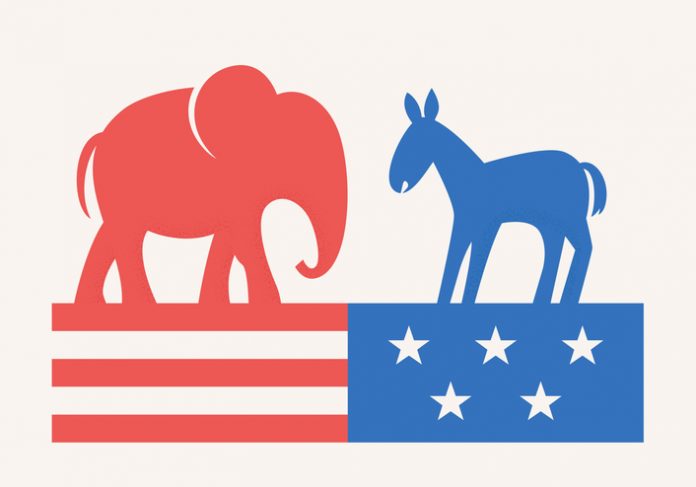By Michael Barone
One of the puzzles in this year’s surprising and unpredicted (including by me) off-year election results is why the Republicans’ 51% to 47% win in the popular vote for House of Representatives did not produce a majority bigger than the apparent 221-214 result. (All numbers here are subject to revision in line with final returns.)
That 51% to 47% margin is identical to Joe Biden’s and Barack Obama’s popular vote margins in 2020 and 2012, respectively. It is just one digit off from George W. Bush’s 51% to 48% win in 2004. It’s almost identical to House Democrats’ 51% to 48% popular vote margin in 2020, which yielded them an almost identical 222-213 majority.
The big contrast is with 2012, when Democrats carried the House popular vote 49% to 48% but won only 201 seats to the Republicans’ 234. How could a party win a 33-seat majority while losing the popular vote, then win only a seven-seat majority while carrying the popular vote by 4 points?
One answer is differential turnout. In 2012, Democrats’ popular vote edge owed much to heavy Black voter turnout to reelect the first Black president. But many of those votes came in overwhelmingly Black districts and did nothing to elect Democrats elsewhere.
This year, differential turnout worked against Democrats. Central city turnout was way down, as compared to the last off-year election in 2018—down 19% in New York City but up 0.3% in the suburbs and upstate; down 13% in Philadelphia, but up 8% elsewhere in Pennsylvania; down 15% in Detroit’s Wayne County, but up 6% elsewhere in Michigan; down 12% in Milwaukee County, but up 1% elsewhere in Wisconsin; down 24% in Chicago’s Cook County, down only 8% in Chicago’s collar counties and downstate.
That reflects population loss in central cities, particularly from Black voters leaving the industrial Midwest for the more economically vibrant and culturally congenial metro Atlanta—making Georgia, with the nation’s third highest Black percentage, a target state. It also reflects, after four years of skyrocketing crime and stringent lockdowns, waning enthusiasm among heavily Democratic electorates. That’s not a favorable sign for Democratic turnout in 2024.
The second reason is that Republicans failed to harvest significant gains in House seats from their significant gain in popular votes in redistricting. Republicans had a big advantage in partisan redistricting following the 2010 census but only a minimal advantage following the 2020 census.
In particular, Democratic mapmakers and supposedly nonpartisan but liberal-leaning redistricting commissions have no longer felt bound by the Voting Rights Act to pack Black people into black-majority districts—a tactic Republicans have encouraged since the 1990 election cycle because it leaves fewer Democratic voters in adjacent districts.
Abandonment of this supposedly immutable principle is responsible, for example, for the fact that Michigan elected zero Black Democratic congressmen for the first time since 1952. (A Black Republican was elected in mostly white, suburban Macomb County.) Democrats also won a state Senate majority for the first time since 1983 by winning districts that linked heavily Black neighborhoods in Detroit with affluent, mostly white suburbs.
The most important reason for the Republicans’ reduced harvest of House seats has been a reduction in clustering. Previously, heavily Democratic voters—Blacks, Hispanics and gentry liberals—have been clustered geographically in central cities, sympathetic suburbs and university towns, while Republican voters have been spread more evenly around the rest of the country.
The effect of clustering can be seen in the number of House districts carried by different presidents. Both Bush and Obama were reelected with 51% of the popular vote. That enabled Bush in 2004 to carry 255 of the 435 House districts. But Obama in 2012 carried only 209. Biden, with 51% in 2020, raised that number to 226.
Democratic clustering has diminished in recent years. Part of the reason is that Democratic groups have become less Democratic. Hispanics voted 29% Republican in 2012 but 39% Republican in 2022. The Asian Republican percentage increased from 25% to around 40%, and the Black Republican percentage increased from 6% to 13%.
Meanwhile, Republican clustering has increased in the wide-open spaces between the Appalachians and the Rockies, from far-out exurbs and in Walmart and Dollar General country beyond.
You can see the evidence from which party won seats with supermajorities. In 2012, 71 Democrats and only 32 Republicans were elected to the House with 70% or more of the vote. Twenty-eight Democrats got 80% or more, whereas only three Republicans did.
This year, by my preliminary count, the 70-plus percent districts moved closer to parity—58 Democrats and 39 Republicans. Only 18 Democrats and five Republicans won with 80% or more.
Thus, the Republicans’ 51% of the total House vote produced a disappointing number of House seats.
However, it also signaled a residual Republican strength. Republican House candidates had a hard time dislodging Democrats in marginal districts. But relatively few were weighted down by highly publicized endorsements of Donald Trump’s backward-looking insistence that the 2020 presidential election was stolen; the few identified with that view ran significantly behind the many who didn’t.
Instead, Republican House candidates ran ahead of their party’s Senate candidates in such states as Pennsylvania, Ohio, Wisconsin, Georgia, Arizona and Nevada. They also ran strongly in tandem with landslide winners Ron DeSantis and Marco Rubio in Florida.
Republican House candidates won 58% of the popular vote in the South and 53% in the Midwest, two regions that together account for 298 of the 538 electoral votes. Duplicating that support is one way an unproblematic Republican nominee could top 270 electoral votes in 2024.
Michael Barone is a senior political analyst for the Washington Examiner, resident fellow at the American Enterprise Institute and longtime co-author of The Almanac of American Politics.
COPYRIGHT 2022 CREATORS.COM
More from Michael Barone











